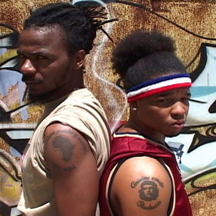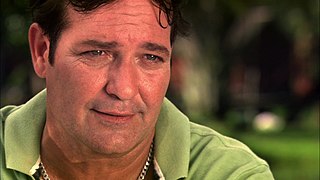Related Research Articles

Havana is the capital and largest city of Cuba. The heart of the La Habana Province, Havana is the country's main port and commercial center. The city had a population of 2,137,847 inhabitants in 2022, and it spans a total of 728.26 km2 (281.18 sq mi) for the capital city side and 8,475.57 km² for the metropolitan zone – making it the largest city by area, the most populous city, and the second largest metropolitan area in the Caribbean region.

Orishas are a Cuban hip hop group from Havana, Cuba, founded in 1999. The group was first called "Amenaza", "threat" or "menace" in Spanish, and appealed to the Cuban youth. The choice of this name for the hip hop group is a way of creating a direct link between this band and the African diaspora. The group is based in France where they made a deal with a record company, although they visit Cuba frequently. In 1999 Fidel Castro threw a party for them and had a meeting with all the musicians. It was the first time the Cuban government showed support for hip hop music. The group was and still is popular in Europe and Latin America. Yotuel Romero and Ruzzo Medina, who moved from Havana to Paris as part of an international studies program, joined Roldán González and Flaco-Pro to form the band in 1999. Their work is influenced by the hip hop movement as well as Cuban and other Latin rhythms. As of October 2009, they had produced a total of five studio albums and a greatest hits album; their latest album is Gourmet. In 2009 they participated in the concert Paz Sin Fronteras II in Plaza de la Revolución, Havana, Cuba. Orishas reunited to record new material in 2016.
Hip hop music arrived in Cuba via radio and TV broadcasts from Miami. During the 1980s hip hop culture in Cuba was mainly centered on breakdancing. But by the 1990s, with the collapse of the Soviet Union and the onset of the Special Period, young raperos, exposed to foreign tourists whose wealth highlighted their struggle, turned to rapping to affirm their cubanidad and advocate for further revolutionary reforms.
Nueva Trova is a movement in Cuban music that emerged around 1967/68 after the Cuban Revolution of 1959, and the consequent political and social changes.

Vedado is a central business district and urban neighborhood in the city of Havana, Cuba. Bordered on the east by Calzada de Infanta and Central Havana, and on the west by the Alemendares River and Miramar / Playa district, Vedado is a more modern part of the city than the areas to the east, developed in the first half of the 20th century, during the Republic period. In 2016 it was described by one commentator as the city's "most affluent" section. The main street running east to west is Calle 23, also known as "La Rampa". The northern edge of the district is the waterfront seawall known as the Malecón, a famous and popular place for social gatherings in the city. The area popularly referred to as 'Vedado' consists of the wards of Vedado, Rampa, Vedado-Malecón and Carmelo, all in the municipality of Plaza de la Revolución.

Centro Habana is one of the 15 municipalities or boroughs in the city of Havana, Cuba. There are many retail spaces (such as Plaza de Carlos III commercial center, office buildings, hotels, bars and clubs. A chinatown - Barrio Chino - is also located in this district. It is a smaller municipality of Havana, and it has the highest population density.

East of Havana is a 2006 documentary film co-produced by South African actress Charlize Theron. The film features three young Cuban rappers: Soandry, Magyori, and Mikki and centers on their experiences in the Cuban underground hip hop scene.

Anónimo Consejo was a Cuban rap duo whose name translates into English as Anonymous Advice. The group consisted of Maigel "MC Kokino" Entenza Jaramillo and Yosmel "MC Sekou" Sarrias, and was known for the social and political themes in their music. It was one of the most popular hip hop groups in Cuba during its prime. In 2011, the duo split to pursue individual interests.
The early/initial visible roots of hip hop in Cuba are believed to have emerged through break dance competitions or battles that were seen on the streets of Cuba. The continuous repetition of break dance battles were one of the strong channels or pioneers of the hip hop culture in Cuba. Some sources state that hip hop in Cuba strongly emerged in the early nineties as a way out due to the termination of the numerous subsidies that were received by the country through the Soviet. All the above-mentioned pertaining to Cuban hip hop is vital - however, none of it would have been successful without the presence of one of the two Cuban Institutions, namely Asociacion Hermanos Saiz and Agencia Cubana de Rap. Asociacion Hermanos Saiz and the latter are the two initial Institutions that were funded by the Cuban Government with the major motive of promoting Rap/hip hop in Cuba more.
Grupo Uno was a group of organizers from an East Havana district cultural center. They brainstormed the radical idea of a Cuban rap festival in 1995. One of the principal organizers, Rodolfo Rensoli, contributed largely to the event by anticipating the need for social and governmental support. Rensoli said that "There are a lot of people who don't understand people like me" as a reason for starting the festival in Cuba. While Grupo Uno gained official support, they had few resources at their disposal. Despite this setback, they were able to spread the word of the festival through the already existent Cuban rap scene. For the first time in Cuban history, moneros were able to express themselves publicly, mentioning many diverse cultural aspects such as race, baseball and the significance of their performance that day, all of which were in their native tongue, Spanish. The event took place in an open-air venue in Alamar, and would continue to occur there annually.

Cojímar is a district in Havana, Cuba, forming a ward that is part of the Habana del Este municipality. Its population is 20,390.

Jorge Perugorría Rodríguez is a Cuban actor, film director and painter. He is well known for his part as Diego in Strawberry and Chocolate (original title in Spanish Fresa y chocolate. He recently acted in Steven Soderbergh's Che, with Benicio del Toro and in the original Netflix series Four Seasons in Havana. He lives in Santa Fe, a neighborhood on the outskirts of Havana, with his wife Elsa Maria Fuentes de La Paz and their four children.
Doble Filo is a Cuban hip-hop band formed in 1995 and composed of Yrak Saenz and Edgaro Gonzalez. The band, which is often compared to Dilated Peoples and The Amorphous, won the Alamar rap Festival's Grand Prize in 1996.

Kumar is a Cuban musician who was born in Havana in 1984. He also appeared as an actor in Benito Zambrano’s movie Habana Blues, and his song "No Se Vuelve Atras" is featured in the movie’s soundtrack.

Telmary Díaz, better known as simply Telmary, is a Cuban rapper, musician, and spoken-word artist.
The following is a timeline of the history of Havana, Cuba.

Danay Suárez is a Cuban R&B and rap singer. She has gained attention in Europe, mainly in France.
Krudas Cubensi, also known as Las Krudas, is an activist hip-hop group with black feminist, queer and vegan politics. Born in Cuba in the 1990s, it is part of the Caribbean diaspora in the United States since 2006. They are now called Krudxs Cubensi, to reflect their non-binary indentity.

Cayo Hueso is a consejo popular (ward) in the municipality of Centro Habana, Havana, Cuba. A traditionally working-class neighborhood populated by Afro-Cubans, it is known for its many cultural landmarks such as the Callejón de Hamel, the Fragua Martiana Museum and the Parque de los Mártires Universitarios.

Laura de la Uz is a Cuban film, television and theatre actress. She appeared in the theatre drama "Un Rayo de Esperanza" in 2020 Cubacultura. She was nominated for Platino Award for Best Actress twice.
References
- ↑ "Margarita Basilia Araujo Suárez". Asamblea Nacional del Poder Popular (in Spanish). Retrieved 2022-09-10.
- 1 2 Baker, Geoffrey. 2006. "La Habana que no conoces: Cuban rap and the social construction of urban space." Ethnomusicology Forum 15, no. 2: 232.
- ↑ Sheila Whiteley, Stan Hawkins, Andy Bennett (Editors). Music, Space and Place: Popular Music and Cultural Identity. Ashgate Publishing, 2005. ISBN 978-0-7546-5574-9; page 96.
- ↑ "Vivero Alamar". Archived from the original on 3 February 2014. Retrieved 24 January 2014.
- ↑ "Organoponico Vivero Alomar -- Cuba". International Co-operative Alliance. Archived from the original on 2 February 2014. Retrieved 27 January 2014.